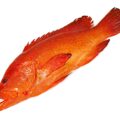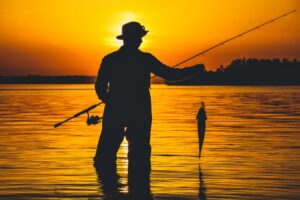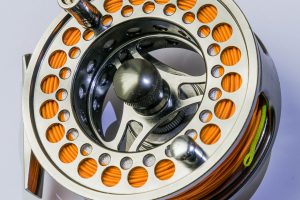Coral grouper is a grouper fish species, a member of the Serranidae family. They are also called leopard grouper, leopard coral grouper, and coral trout. They are commonly found in the Indo-Pacific region, including the Red Sea, Indian Ocean, and western and central Pacific Oceans. Besides, they can be found at depths of up to 100 meters and like to reside in lagoons, rocky outcrops, and coral reefs.

Physical Characteristics
The Coral Grouper has a typical grouper morphology, with a thick, strong body that tapers toward the tail. Their teeth are tiny and sharp, with huge heads and wide mouths. The pupils of the eyes, which can be either green or yellow, are comparatively large. Coral groupers are renowned for their distinct and eye-catching coloring. The body is often pinkish-white and has a characteristic pattern of brown, orange, and red spots that cover the entire body, giving them the appearance of a leopard. These spots are not all the same and might differ in size and body area among these species.
Habitat and Distribution
Coral groupers can be found in a variety of environments, such as lagoons, rocky outcrops, and coral reefs. They are flexible and adaptable species that can be found in depths ranging from a few meters to as much as 100 meters. The Coral Grouper has a large geographic range and may be found in the western and central Pacific, Red Sea, and Indian Ocean. They are very common in the areas surrounding Australia, where recreational fishermen frequently catch them.
Behavior and Diet
Coral groupers are lonely fish that spend most of their time in the ocean’s depths, hidden in cracks and underneath rocks. They typically defend their hiding locations from intruders because they are territorial. Coral groupers have a wide variety of food items in their diets since they are carnivorous predators. They consume a variety of small fish, crustaceans, and other invertebrates as food, although they are particularly known to enjoy octopus and squid. Also, they are renowned for being opportunistic eaters, taking advantage of any available prey.
Reproduction
Coral groupers are slow-growing fish that often take several years to achieve sexual maturity. Furthermore, they are renowned for their unusual and fascinating reproductive habits. Male Coral Groupers establish territories on the sea bottom and begin to draw in females during the spawning season, which normally lasts from late spring to early summer.
They achieve this by vibrating their swim bladders, which results in a drumming sound. When a female joins a male’s region, the male species will guide the female to a crevice or cave where she will lay her eggs; afterward, the male fertilizes the eggs and protects them till they spawn. This behavior is unique among fish species, which is one of the reasons coral groupers are so fascinating to study.
Conservation Status
Coral Groupers are an important commercial fish species, and they are widely harvested throughout their range. Unfortunately, this has led to overfishing in some areas, and Coral Groupers are now considered to be a vulnerable species.
To address this problem, many countries have implemented regulations to limit the size and number of Coral Groupers that can be caught, and some areas have established marine protected areas where fishing is prohibited. These measures have had some success in helping to conserve Coral Grouper populations, but there is still much work to be done to ensure the long-term survival of this species. In addition to overfishing, Coral Groupers are also threatened by habitat loss and degradation. As coral reefs around the world continue to decline, Coral Groupers and other reef-associated species are at risk of losing their homes and their food sources.
Is leopard coral grouper edible?
They are edible. This grouper species has gained popularity among health-conscious consumers because it is delicious and nutrient-rich.
Are coral groupers suitable to keep in an aquarium?
Coral groupers can certainly be kept in aquariums, but they need a larger tank with many hiding places and balanced food. Before attempting to keep them in captivity, it is crucial to understand their needs.
Are coral groupers in danger?
Coral groupers are endangered. Due to overfishing and loss of habitat, several species of coral groupers are regarded as being in threat of extinction. In order to ensure their survival, it is critical to use sustainable fishing techniques and safeguard their natural habitats.
How large can a coral grouper grow?
Coral groupers are normally smaller to average in size; however, they can reach lengths of up to 120 cm (4 feet) and weights of up to 50 kg (110 lbs). Male Coral Groupers can grow up to 20 inches (50 cm) in length.
Although females often don’t go past 10 inches (25 cm). Males are typically larger than females. Nonetheless, a Coral Grouper’s size might vary based on its species and surroundings.
What Is the Lifespan of a Coral Grouper?
The life span of a coral grouper is 20 years. However, conflicting information exists regarding the coral rock cod’s lifespan. According to some reports, groupers often live between 9 and 37 years.
Conclusion
These predatory fish are frequently found in coral reefs and other rocky habitats in the Indo-Pacific and subtropical regions. Coral groupers are sought-after species for recreational fishing because of their outstanding morphological characteristics.
-
- The coral grouper is typically small to average in size, although it can grow to 120 cm (4 ft) and weighs 50 kg (110 lbs).
-
- They prefer to live in lagoons, rocky outcrops, and coral reefs and can be found at depths of up to 100 meters.
-
- Coral groupers are solitary fish that spend most of their time in the ocean’s depths, tucked up behind rocks and crevices.
-
- They eat several kinds of tiny fish, crabs, and other insects.
However, several species of coral groupers are currently threatened with extinction due to overfishing and habitat loss, making it essential to use sustainable fishing methods and safeguard their natural habitats to ensure survival.











